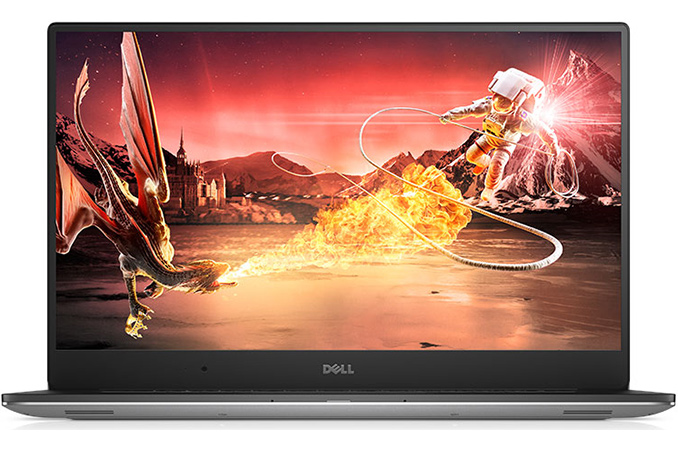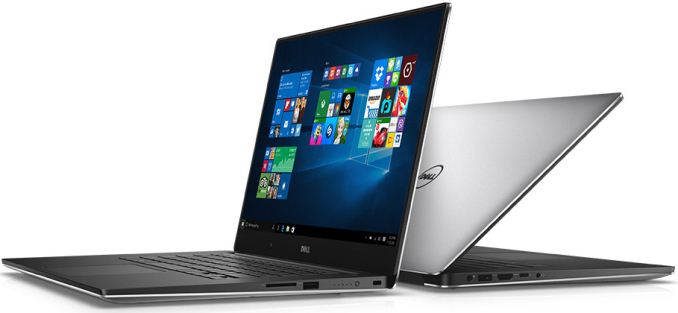Dell Readies New XPS 15: 4K, Quad-Core Kaby Lake, GeForce GTX 1050
by Anton Shilov on December 23, 2016 4:00 PM EST
Dell has accidentally published near-final specifications of its upcoming XPS 15 notebook due to be released early next year. The Dell XPS 15 computers are designed for performance-demanding users seeking near bezel-less laptops with above-average performance at a moderate price with a plenty of upgrade options. The new XPS 15 9560 will receive Intel’s Kaby Lake processor, NVIDIA’s GeForce GTX 1050-series graphics as well as some other optional upgrades not available on current-gen, but will retain the internal architecture and external design.
According to the listing (now removed from the website) Dell’s upcoming XPS 15 9560 notebook will use either a dual-core Intel Core i3-7100HQ, a quad-core Core i5-7300HQ or a quad-core Core i7-7700HQ CPU. The aforementioned chips are not yet formally announced, but it is known that they are based on the Kaby Lake microarchitecture and will thus offer improved performance compared to predecessors due to higher frequencies, Speed Shift v2 technology and other refinements. For those who opt for iGPU rather than a discrete model it is important to note that the Kaby Lake CPUs also has an improved video encoding/decoding engine.
The next key enhancement of the XPS 15 9560 over the current-generation XPS 9550 will be NVIDIA’s GeForce GTX 1050 GPU with up to 4 GB of GDDR5 memory. NVIDIA has yet has to announce a mobile version of the GeForce GTX 1050, but it is highly likely that the product is based on the GP107 GPU featuring the Pascal architecture and up to 768 stream processors, similar to the desktop version. The new graphics chip should offer a decent performance upgrade when compared to the GeForce GTX 960M used in the current-gen XPS 15. Meanwhile for those planning to play demanding games it makes sense to look at the GeForce GTX 1060 or 1070, which means the Alienware 15.
Since the new Dell XPS 15 9560 will retain the chassis of its predecessor, it will support similar InfinityEdge 15.6” display panels: an IPS FHD (1920×1080) or an IGZO UHD (3840×2160) with 100% AdobeRGB color gamut and touch support. Physical dimensions of the unit also remain intact with the predecessor: it weighs around 1.8 kilograms and is up to 17 mm thick.
For storage, the new Dell XPS 15 will use either Seagate’s SSHDs or PCIe SSDs with up to 1 TB capacity. Meanwhile, due to improvements of Kaby Lake’s memory controller, the new laptops should be compatible with DDR4-2400 memory, offering an additional performance boost over DDR4-2133 used today.
As for connectivity, the XPS 9550 uses Rivet Networks' Killer 1535 802.11 2×2 Wi-Fi + BT 4.1 controller, has one Thunderbolt 3/USB 3.1 Type-C port, two USB 2.0 headers, an HDMI output, a 720p webcam and an SD card reader, which essentially means that there is nothing for the XPS 9560 to upgrade here (at least, not without a major redesign of the whole PC). However, since the XPS machines are often used like workstations, Dell decided to add a fingerprint reader with Windows Hello support as an option.
Since Dell has already taken down the XPS 9560 product page (technically, it is there, but without any data), so prices and exact final configurations / availability dates remain under wraps. Still, being a close partner of Intel and NVIDIA, Dell is typically among one of the first to release PCs based on the new CPUs/GPUs. Therefore we expect the new systems to arrive shortly after CES in the usual XPS 15 price range that starts at $999 and ends at ~$2500 for high-end models.
Related Reading:
- Best Gaming Laptops: Holiday 2016
- Alienware Refreshes The Alienware 15 And 17 Gaming Notebooks At PAX
- Razer Re-Launches The Razer Blade Pro: GTX 1080 And 4K G-SYNC
- The ASUS ROG Strix GL502VS Review: Mainstream GTX 1070 with G-SYNC
Sources: PCMag, WindowsCentral.


















102 Comments
View All Comments
vladx - Saturday, December 24, 2016 - link
Unfortunately the 15" laptops that have an Ethernet port and are also light don't offer all the options a XPS does. So I'm sorry to tell you but your analogy doesn't work in this case.forgot2yield28 - Saturday, December 24, 2016 - link
The whole point of the XPS 15 is to pack in major performance into an almost-ultrabook like body. If you want more functionality, get an Inspiron 7000 series. You get similar internals plus the ethernet port, in a comparatively chunky (but still nice looking) plastic body. No one's being suckered, the company is giving you options and XPS buyers prioritize thin-and-light. I need to run AutoCAD on 4 hour coast to coast flights but I have almost 0 need for gigabit ethernet. This thing sounds fantastic.vladx - Saturday, December 24, 2016 - link
That's my point, they could make it a few mm thicker to pack an Ethernet port and still call it an ultrabook as the upper limit oir the class is around 0.8 inches. There's no such ultrabook only because suckers like you are willing to spend on additional adapters and hubs.lazarpandar - Saturday, December 24, 2016 - link
Man you're being unnecessarily aggressive right now. Stop calling people suckers please. Just go out and find a notebook that matches your needs. I personally am, and many others are 100% fine using an adapter in the rare situations that I need ethernet.Lenovo has an ultrabook with ethernet iirc, by the way.
vladx - Saturday, December 24, 2016 - link
Like I already said, there's no 15" laptop that offers as many options as an XPS and is also light and well built like it. You can call me a troll or whatever, but facts are facts.lazarpandar - Saturday, December 24, 2016 - link
Facts aren't what I'm disputing here, it's your delivery. Stop being adversarial and calling people names please.Manch - Monday, December 26, 2016 - link
ASUS Zenbook Pro has the same exact specs as the XPS. Just as thin. It is larger over all bc bezel, but it has a full KB to include # pad which I like. Also the SSD doesn't throttle like the XPS. Comes with a USB/Ethernet port adapter. It's well built and has similar reviews to the XPS.Manch - Monday, December 26, 2016 - link
You don't like wasting other ports or having cables stick out of your laptop? So why would you care about a Ethernet port? An adapter isn't that bulky. Plugs the cable into the adapter and then into the usb. When done, put the adapter away. Yeah they could sacrifice a USB port for an Ethernet port but why? More USB is better. USB is more versatile than an Ethernet port. You don't suffer from less functionality, you have more.Flying Aardvark - Thursday, December 29, 2016 - link
That's what a dock is for.Meteor2 - Saturday, December 24, 2016 - link
How would an adapter work if you wanted to use a second USB-C device? Use a hub too?The main thing wrong with this design is having just one port of the new standard. Apple did it right with four on the new MacBook Pros.